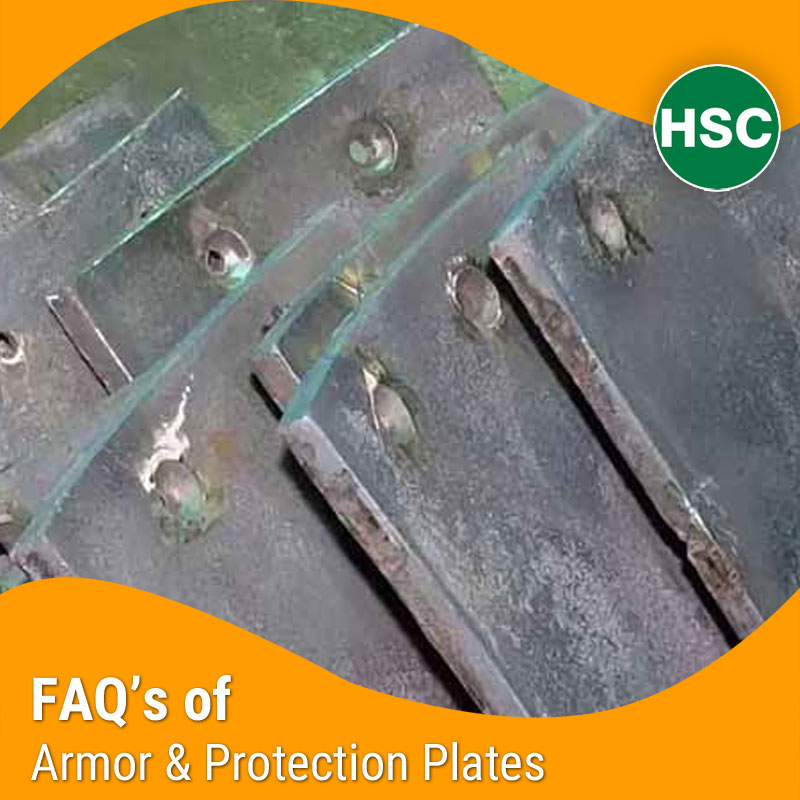When selecting armor steel plates for defense, vehicle, or infrastructure protection, one of the most common buyer questions is:
“What is the difference between RHA and HHA plates?”
At Hindustan Steel Corporation, we help buyers make the right choice between Rolled Homogeneous Armor (RHA) and High Hardness Armor (HHA), depending on ballistic threat levels, weight requirements, and application zones.
Meaning of RHA (Rolled Homogeneous Armor) vs HHA (High Hardness Armor)
| Term | Full Form | Hardness Range | Common Usage |
|---|---|---|---|
| RHA | Rolled Homogeneous Armor | 250–300 BHN | Blast protection, structural reinforcement, general vehicle armor |
| HHA | High Hardness Armor | 470–540 BHN | Multi-hit rifle and armor-piercing bullet protection, ballistic doors, vehicle sidewalls |
Applications Where RHA and HHA are Used Differently
RHA Plates Are Used For:
- Underbody blast shields
- Structural frames of armored vehicles
- General ballistic protection for low-level threats
- Shock-absorbing parts in defense infrastructure
HHA Plates Are Used For:
- Vehicle sidewalls and doors
- Ballistic shields
- Bulletproof doors and security walls
- Multi-hit rifle and AP round protection zones
Mechanical Property Comparison: RHA vs HHA
| Property | RHA | HHA |
|---|---|---|
| Hardness | 250–300 BHN | 470–540 BHN |
| Yield Strength | Lower | Higher |
| Tensile Strength | Lower | Higher |
| Elongation | Higher (more ductile) | Lower (more brittle) |
| Impact Toughness | High | Moderate |
| Ballistic Rating | Low (Blast/Low Threat) | High (Rifle/AP Protection) |
Standards to Fabrication (H5 to H10)
International Standards for RHA and HHA Plates
RHA Plates Are Typically Supplied As Per:
- MIL-DTL-12560 (Class 1 and 2)
- Indian Defense Grade Equivalents
HHA Plates Are Typically Supplied As Per:
- MIL-DTL-46100
- STANAG 4569 Level 2/3 Zones
- EN 1522 FB6 / FB7 (Material Level Equivalents)
- HIND ARMOR 500 and HSC 500T (Hindustan Steel Corporation Proprietary Grades)
Thickness Range and Available Sizes for Both Types
| Type | Thickness Range |
|---|---|
| RHA | 6 mm to 50 mm |
| HHA | 6 mm to 50 mm |
Size Options:
Width: Up to 2500 mm
Length: Up to 12000 mm
Custom Cut-to-Size: ✅ Yes
CNC Drilling / Profiling: ✅ Yes
Heat Treatment and Toughness Differences
RHA Plates:
- Typically supplied in annealed or normalized condition
- Focused on ductility and blast energy absorption
HHA Plates:
- Supplied in quenched and tempered condition
- Focused on surface hardness and ballistic stopping power
Impact Toughness:
RHA offers better toughness
HHA offers better hardness and bullet resistance
Fabrication and Welding Considerations
| Fabrication Step | RHA | HHA |
|---|---|---|
| Cutting | Easier | Needs careful heat control |
| Drilling | Easier | Requires carbide tools and coolant |
| Welding | Standard practices | Needs preheat and low hydrogen electrodes |
| Forming/Bending | Easier | Limited (especially for thicker plates) |
For multi-threat applications, buyers often use a combination of RHA and HHA layers.
Why Buy RHA and HHA Plates from Hindustan Steel Corporation?
- One-stop source for both RHA and HHA grades
- Made-in-India alternatives to imported defense armor steel
- ustom size, drilling, and CNC profiling
- Ballistic test support for OEMs and defense projects
- Export-ready packaging with full documentation
- Competitive pricing and fast dispatch
We supply both Indian defense contractors and global OEM armor fabricators.
Related Grades / Buyer Alternatives
If you’re comparing RHA and HHA, you may also want to explore:
- HIND ARMOR 500 Plates
- HSC 500T Tactical Armor Plates
- MIL-DTL-12560 Class 1 / 2 RHA Plates
- MIL-DTL-46100 HHA Plates
- STANAG 4569 Level Armor Steel
Our technical team can help with grade selection for your project.
Export Destinations and Packaging
We export RHA and HHA plates to:
- UAE, Saudi Arabia, South Africa, Germany, Nigeria, Kenya, and more.
Packaging Includes:
- Seaworthy pallets/crates
- VCI anti-corrosion wrapping
- Labeling by grade, thickness, and heat number
- Export documents: MTC, Packing List, Commercial Invoice, Ballistic Test Reports (on request)
How to Choose Between RHA and HHA Plates?
Choose RHA for:
- Blast zones, structural parts, and low-velocity threat protection
Choose HHA for:
- Direct bullet resistance, rifle threats, and armor-piercing protection
For multi-threat applications, consider layered designs using both RHA and HHA.
Discuss your project details with our technical team for exact recommendations.
Certifications, Testing, and Quality Control
For every order, we provide:
- Mill Test Certificates (MTC)
- Hardness Test Reports
- Ballistic Test Reports (chargeable, on request)
- Third-Party Inspection Certificates (SGS, BV, Lloyds, etc.)
- Ballistic Compliance Declaration
FAQs: RHA vs HHA Plates
What is the difference between RHA and HHA plates?
RHA = Lower hardness, better ductility. HHA = Higher hardness, better bullet resistance.
What hardness is RHA armor steel?
Around 250–300 BHN.
What hardness is HHA steel?
Typically 470–540 BHN.
Can I weld RHA and HHA plates?
Yes, with proper techniques.
What standards cover RHA plates?
MIL-DTL-12560 Class 1/2.
What standards cover HHA plates?
MIL-DTL-46100, STANAG 4569, etc
Do you provide ballistic test reports?
Yes, on request.
Can I mix RHA and HHA in the same project?
Yes, for layered armor designs
What is the delivery time?
5–7 working days for stock thicknesses.
How do I get a quote?
Call, email, or WhatsApp with thickness, grade, and destination details.
Need help choosing between RHA and HHA plates for your armor project?
Contact Hindustan Steel Corporation today
Ask for:
- Datasheets for both RHA and HHA grades
- Hardness and ballistic comparison charts
- Cut-to-size and drilling service

